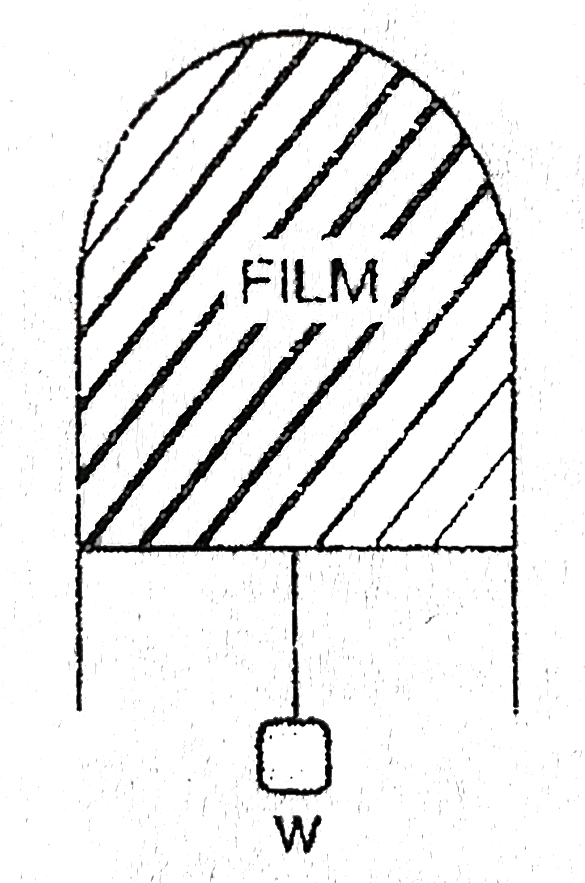A drop of some liquid of volume 0.04cm3 is placed on the surface of a glass slide. Then, another glass forms a thin layer of area 20cm2 between the surfaces of the two slides. To separate the slides a force of 16×105 dyne has to be applied normal to the surfaces. The surface tension of the liquid is (in dyne cm−1)
60
70
80
90
The correct Answer is:C
To find the surface tension of the liquid, we can follow these steps:
Step 1: Write down the given values
- Volume of the liquid (V) = 0.04 cm³
- Area of the layer (A) = 20 cm²
- Force applied (F) = 16 × 10⁵ dyne
Step 2: Calculate the thickness (length) of the liquid layer
The thickness (l) of the liquid layer can be calculated using the formula:
l=VA
Substituting the values:
l=0.04cm320cm2=0.002cm
Step 3: Calculate the radius (r)
Since the thickness of the liquid layer is considered as the diameter, the radius (r) is half of the thickness:
r=l2=0.002cm2=0.001cm
Step 4: Relate surface tension (S) to the pressure (P)
The excess pressure (P) due to surface tension is given by:
P=Sr
Where:
- S = surface tension
- r = radius
Step 5: Calculate pressure (P) using force and area
Pressure can also be defined as:
P=FA
Substituting the values:
P=16×105dyne20cm2=8×104dyne/cm2
Step 6: Set the two expressions for pressure equal to each other
From the previous steps, we have:
Sr=FA
Substituting for P:
S0.001cm=8×104dyne/cm2
Step 7: Solve for surface tension (S)
Rearranging the equation gives:
S=P⋅r
Substituting the values:
S=(8×104dyne/cm2)⋅(0.001cm)=80dyne/cm
Final Answer
The surface tension of the liquid is 80 dyne/cm.
- Volume of the liquid (V) = 0.04 cm³
- Area of the layer (A) = 20 cm²
- Force applied (F) = 16 × 10⁵ dyne
The thickness (l) of the liquid layer can be calculated using the formula:
l=VA
l=0.04cm320cm2=0.002cm
Since the thickness of the liquid layer is considered as the diameter, the radius (r) is half of the thickness:
r=l2=0.002cm2=0.001cm
The excess pressure (P) due to surface tension is given by:
P=Sr
Where:
- S = surface tension
- r = radius
Pressure can also be defined as:
P=FA
Substituting the values:
P=16×105dyne20cm2=8×104dyne/cm2
From the previous steps, we have:
Sr=FA
Substituting for P:
S0.001cm=8×104dyne/cm2
Rearranging the equation gives:
S=P⋅r
Substituting the values:
S=(8×104dyne/cm2)⋅(0.001cm)=80dyne/cm
The surface tension of the liquid is 80 dyne/cm.
Topper's Solved these Questions
Similar Questions
Knowledge Check
A thin liquid film formed between a U−shaped wire and a light slider supports a weight of 1.5×10−2N(see figure). The length of the slider is 30cm and its weight negligible. The surfaces tension of the liquid film is :
 A0.0125Nm−1B0.1Nm−1C0.05Nm−1D0.025Nm−1
A0.0125Nm−1B0.1Nm−1C0.05Nm−1D0.025Nm−1
A thin liquid film formed between a U−shaped wire and a light slider supports a weight of 1.5×10−2N(see figure). The length of the slider is 30cm and its weight negligible. The surfaces tension of the liquid film is :

View SolutionA 10 cm long wire is placed horizontal on the surface of water and is gently pulled up with a force of 2×10−2 N to keep the wire in equilibrium. The surface tension, in Nm−1 of water is
View SolutionTwo vertical glass plates 1 mm apart are dipped into water. How high will the water rise between the plates. If the surface tension of water is 70 dyne cm−1
View SolutionA liquid is kept in a beaker of radius 4 cm. Consider a diameter of the beaker on the surface of the water. Find the force by which the surface on one side of the diameter pulls the surface on the other side. Surface tension of liquid =0.075Nm−1
View SolutionA thin film of liquid is formed in a rectangular frame of wire and a light slider supports a weight of (2.5⋅10−2)N.The length of slider is 20cm and its weight negligible. The surface tension is liquid is
_PHY_E03_002_Q01.png)
View SolutionA drop of water of volume 0.05cm3 is pressed between two glass plates, as a consequence of which, it spreads and occupies an are of 40cm2. If the surface tension of water is 70dyne/cm, find the normal force required to separate out the two glass plates is newton.
View SolutionA rectangular glass plate of dimensions 5 cm × 4 cm is placed flat on the surface of water. Find the downward force on the plate due to surface tension. Given surface tension of water = 0.073 N m−1
View Solution
